Beyond Traditional Public Transport: A Cost–Benefit Analysis of First and Last-Mile AV Solutions in Periurban Environment
Abstract
1. Introduction
2. Method
2.1. Simulation Model
2.1.1. MATSIM
2.1.2. EQASIM
- probability to chose to alternative i
- estimated utility of alternative i
- estimated utilities of all i alternatives
2.2. Simulation of On-Demand Mobility Systems
2.3. Cost Benefit Analysis
2.3.1. Consumer Surplus
2.3.2. Operator Profits
2.3.3. Externalities Impacts
2.3.4. Indicators for Scenario Comparisons
- -
- Winners versus Losers: This indicator captures the share of agents who experience an improvement (winners), a deterioration (losers), or no change (indifferent) in their utility compared to the baseline scenario, expressed as a percentage of the total agent population.
- -
- The 10% Measure: This metric evaluates the concentration of benefits by estimating the proportion of total positive consumer surplus accrued by the top 10% of agents who gain the most from the project, expressed as a percentage of aggregate gains.
- -
- Gini Index: A Gini coefficient is calculated based on the distribution of individual gains and losses, providing a summary measure of inequality in the welfare impacts among consumers.
3. Use Case
3.1. Territory
3.2. Scenarios
4. Results
4.1. Simulations Results and Discussion
4.1.1. General Results
4.1.2. A Focus on the AVs
4.1.3. Consumer Surplus (CS)
4.1.4. Operator Profits
4.1.5. Externalities
4.2. Net Present Value
5. Recommendations for Decision Makers
- -
- Prioritize Stop-Based routing with constrained networks: Given the significant cost savings in infrastructure investment and maintenance, and the improved net present value, decision-makers should strongly consider implementing Stop-Based AV feeder services that utilize or are restricted to existing public transport networks (e.g., bus networks). This approach offers a pragmatic solution for periurban areas.
- -
- Evaluate larger vehicle capacities: The findings suggest that 8-seater AV shuttles can offer better operational efficiency compared to 4-seater AV cars, leading to improved average vehicle occupancy and better demand absorption. This could be a key consideration for fleet design.
- -
- Address potential congestion hotspots: As AV feeder services can increase congestion around train stations, strategies to modify or manage these interchange points should be explored to ensure smooth integration with existing public transit.
- -
- Account for negative externalities: Be prepared for potential increases in VKT and associated externalities (CO2, noise, road safety), even with the goal of supporting public transit. Further research into policies that could mitigate these impacts, such as incorporating induced demand into planning, is warranted.
- -
- Targeted service deployment: Recognize that the benefits of this type of AV feeder service may be concentrated among a minority of users. Policy development should consider how to broaden access to benefits or address potential equity concerns.
- -
- This study underscores that while on-demand AV feeder services can enhance traveler utility in periurban environments, their successful and sustainable implementation hinges on careful service design, particularly regarding routing strategies and network integration, to manage costs and mitigate negative externalities.
6. Conclusions
Author Contributions
Funding
Institutional Review Board Statement
Informed Consent Statement
Data Availability Statement
Conflicts of Interest
Appendix A
Appendix A.1
| Title | Format | Source/Provider | Used Version |
|---|---|---|---|
| Individus localisés au canton-ou-ville - Zone A | dbase | INSEE | 2015 |
| Mobilités professionnelles des individus: déplacements commune de résidence/commune de travail | dbase | INSEE | 2015 |
| Mobilités scolaires des individus: déplacements commune de résidence/commune de scolarisation | dbase | INSEE | 2015 |
| Population en 2015-IRIS-France hors Mayotte dbase INSEE 2015 | dbase | INSEE | 2015 |
| Base niveau communes | xls | INSEE | 2015 |
| Base niveau administratif | xls | INSEE | 2015 |
| Équipements géolocalisés (commerce, services, santé…) | csv | INSEE | 2020 |
| Enquête nationale transports et déplacements (ENTD) | csv | Ministère de la transition écologique et de la cohésion des territoires | 2008 |
| Contours IRIS | IGN/INSEE | 2017 | |
| Découpage infracommunal | xls | INSEE | 2017 |
| Base Sirene des entreprises et de leurs établissements | csv | 2021 | |
| La modélisation 2D et 3D du territoire et de ses infrastructures sur l’ensemble du territoire français | 2021 | ||
| Cartographie OpenStreetMap pour la région Ile-de-France | OpenStreetMap | 2021 | |
| Horaires prévues sur les lignes de transport en commun d’Ile-de-France | GTFS | IDFM | 2022 |
Appendix A.2
| Car | αcar | 1.35 | |
| βtravelTime,car | −0.0667 | [min−1] | |
| Public Transport | αpt | 0.0 | |
| βnumberOfTransfers | −0.17 | ||
| βin VehicleTime | −0.017 | [min−1] | |
| βtransferTime | −0.0484 | [min−1] | |
| βaccessEgressTime | −0.0804 | [min−1] | |
| Bike | αbike | 0.1 | |
| βtravelTime,bike | −0.15 | [min−1] | |
| βage,bike | −0.0496 | [a−1] | |
| Walk | αwalk | 1.43 | |
| βtravelTime,walk | −0.09 | [min−1] | |
| Others | βcost | −0.206 | [EUR−1] |
| λ | −0.4 | ||
| θaverageCrowflyDistance | 40 | [km] | |
| Calibration | θparkingSearchPenalty | 4 | [min] |
| θaccessEgressWalkTime | 4 | [min] |
References
- Anderson, J.; Kalra, N.; Stanley, K.; Sorensen, P.; Samaras, C.; Oluwatola, O. Autonomous Vehicle Technology: A Guide for Policymakers; RAND Corporation: Santa Monica, CA, USA, 2016. [Google Scholar] [CrossRef]
- Kolarova, V. Measuring, Analysing and Explaining the Value of Travel Time Savings for Autonomous Driving. 2021. Available online: https://edoc.hu-berlin.de/items/05e97921-788a-44c8-b781-727eafa385a5 (accessed on 1 June 2025).
- Berrada, J. Technical-Economic Analysis of Services Based on Autonomous Vehicles; Paris-Est: Marne-la-Vallée, France, 2019. [Google Scholar]
- Carreyre, F. Est-ce que les Véhicules Autonomes Valent le Coût? Services de Véhicules Autonomes à la Demande dans Différents Territoires, une Analyse Coût Bénéfice. Ph.D. Thesis, ENPC, Marne-la-vallée, France, 2023. Available online: https://theses.fr/s233183 (accessed on 9 April 2024).
- Greenblatt, J.B.; Shaheen, S. Automated Vehicles, On-Demand Mobility, and Environmental Impacts. Curr. Sustain. Renew. Energy Rep. 2015, 2, 74–81. [Google Scholar] [CrossRef]
- Liu, F.; Zhao, F.; Liu, Z.; Hao, H. Can autonomous vehicle reduce greenhouse gas emissions? A country-level evaluation. Energy Policy 2019, 132, 462–473. [Google Scholar] [CrossRef]
- Bauer, G.S.; Greenblatt, J.B.; Gerke, B.F. Cost, Energy, and Environmental Impact of Automated Electric Taxi Fleets in Manhattan. Environ. Sci. Technol. 2018, 52, 4920–4928. [Google Scholar] [CrossRef]
- Yang, C.Y.D.; Fisher, D.L. Safety impacts and benefits of connected and automated vehicles: How real are they? J. Intell. Transp. Syst. 2021, 25, 135–138. [Google Scholar] [CrossRef]
- Carreyre, F.; Chouaki, T.; Coulombel, N.; Berrada, J.; Bouillaut, L.; Hörl, S. On-Demand Autonomous Vehicles in Berlin: A Cost–Benefit Analysis. Transp. Res. Rec. 2023, 2678, 13–30. [Google Scholar] [CrossRef]
- Berrada, J.; Poulhès, A. Economic and socioeconomic assessment of replacing conventional public transit with demand responsive transit services in low-to-medium density areas. Transp. Res. Part A Policy Pract. 2021, 150, 317–334. [Google Scholar] [CrossRef]
- Bösch, P.M.; Ciari, F.; Axhausen, K.W. Transport Policy Optimization with Autonomous Vehicles. Transp. Res. Rec. 2018, 2672, 698–707. [Google Scholar] [CrossRef]
- Merlin, L. Comparing Automated Shared Taxis and Conventional Bus Transit for a Small City. J. Public Transp. 2017, 20, 19–39. [Google Scholar] [CrossRef]
- Carreyre, F.; Coulombel, N.; Berrada, J.; Bouillaut, L. Economic evaluation of autonomous passenger transportation services: A systematic review and meta-analysis of simulation studies. Rev. D’économie Ind. 2022, 178179, 89–138. [Google Scholar]
- Sieber, L.; Ruch, C.; Hörl, S.; Axhausen, K.W.; Frazzoli, E. Improved public transportation in rural areas with self-driving cars: A study on the operation of Swiss train lines. Transp. Res. Part A Policy Pract. 2020, 134, 35–51. [Google Scholar] [CrossRef]
- Gurumurthy, K.M.; Kockelman, K.M.; Zuniga-Garcia, N. First-Mile-Last-Mile Collector-Distributor System using Shared Autonomous Mobility. Transp. Res. Rec. 2020, 2674, 638–647. [Google Scholar] [CrossRef]
- Huang, Y.; Kara, K.; Garikapati, V.; Zhu, L.; Young, S. Use of Shared Automated Vehicles for First-Mile Last-Mile Service Micro-Simulation of Rail-Transit Connections in Austin, Texas. vol. Transportation Research Record. 2020. Available online: https://www.caee.utexas.edu/prof/kockelman/public_html/TRB20FMLMforAustinSUMO.PDF (accessed on 26 June 2025).
- Lee, Y.-J.; Meskar, M.; Nickkar, A.; Sahebi, S. Development of an Algorithm for Optimal Demand Responsive Relocatable Feeder Transit Networks Serving Multiple Trains and Stations. Urban Rail Transit 2019, 5, 186–201. [Google Scholar] [CrossRef]
- Chouaki, T.; Hörl, S.; Puchinger, J. Towards Reproducible Simulations of the Grand Paris Express and On-Demand Feeder Services. In Proceedings of the Presented at the 102nd Annual Meeting of the Transportation Research Board (TRB 2023), Washington, DC, USA, 8–12 January 2023; Available online: https://hal.science/hal-03788331 (accessed on 31 March 2023).
- Horni, A.; Nagel, K.; Berlin, T.U.; Axhausen, K.W. The Multi-Agent Transport Simulation MATSim; Ubiquity Press: London, UK, 2016. [Google Scholar] [CrossRef]
- McFadden, D. Conditional logit analysis of qualitative choice behavior. In Frontiers in Econometrics; Academic Press: New York, NY, USA, 1974. [Google Scholar]
- Ben-Akiva, M.E.; Lerman, S.R. Discrete Choice Analysis: Theory and Application to Travel Demand; MIT Press: Cambridge, MA, USA, 1985. [Google Scholar]
- Train, K. Discrete Choice Methods with Simulation; Cambridge University Press: Cambridge, UK, 2002; Available online: https://eml.berkeley.edu/books/choice2.html (accessed on 25 December 2022).
- de Dios Ortúzar, J.; Willumsen, L.G. Discrete Choice Models. In Modelling Transport; John Wiley & Sons, Ltd.: Hoboken, NJ, USA, 2011; pp. 227–268. [Google Scholar] [CrossRef]
- Hörl, S.; Balac, M.; Axhausen, K. Pairing Discrete Mode Choice Models and Agent-Based Transport Simulation with MATSim; Transportation Research Board: Washington, DC, USA, 2018. [Google Scholar]
- Hörl, S. Integrating discrete choice models with MATSim scoring. Procedia Comput. Sci. 2021, 184, 704–711. [Google Scholar]
- Hörl, S.; Balac, M.; Axhausen, K. Dynamic demand estimation for an AMoD system in Paris. In Proceedings of the 2019 IEEE Intelligent Vehicles Symposium (IV), Paris, France, 9–12 June 2019. [Google Scholar] [CrossRef]
- Maciejewski, M.; Nagel, K. Simulation and dynamic optimization of taxi services in MATSim. In Transportation Science; TU Berlin: Berlin, Germany, 2013; p. 34. [Google Scholar]
- de Rus, G.; Socorro, M.; Campos, J.; Graham, D.; Valido, J.; Johansson, P.-O. Methodology for the cost-benefit analysis of transport projects and policies. In Independent Authority of Fiscal Responsibility; AIReF: Madrid, Spain, 2020. [Google Scholar]
- Boadway, R.W. The Welfare Foundations of Cost-Benefit Analysis. Econ. J. 1974, 84, 926–939. [Google Scholar] [CrossRef]
- Boardman, A.E.; Greenberg, D.H.; Vining, A.R.; Weimer, D.L. Cost-Benefit Analysis: Concepts and Practice; Cambridge University Press: Cambridge, UK, 2017. [Google Scholar]
- OECD. Cost-Benefit Analysis and the Environment: Further Developments and Policy Use; OECD: Paris, France, 2018. [Google Scholar] [CrossRef]
- Asplund, D.; Eliasson, J. Does uncertainty make cost-benefit analyses pointless? Transp. Res. Part A Policy Pract. 2016, 92, 195–205. [Google Scholar] [CrossRef]
- Börjesson, M.; Eliasson, J. Should values of time be differentiated? Transp. Rev. 2019, 39, 357–375. [Google Scholar] [CrossRef]
- Beria, P.; Maltese, I.; Mariotti, I. Multicriteria versus Cost Benefit Analysis: A comparative perspective in the assessment of sustainable mobility. Eur. Transp. Res. Rev. 2012, 4, 137–152. [Google Scholar] [CrossRef]
- Congress. Flood Control Act of 1936; U.S. Government Publishing Office: Washington, DC, USA, 2018.
- Quinet, E. L’Evaluation Socioéconomique des Investissements Publics. Commissariat Général à la Stratégie et à la Prospective. 2013. Available online: https://www.strategie-plan.gouv.fr/files/files/Publications/Rapport/cgsp_evaluation_socioeconomique_29072014.pdf (accessed on 1 June 2025).
- Document: Cost Benefit Analysis Guidelines. Millennium Challenge Corporation. Available online: https://www.mcc.gov/resources/doc/cost-benefit-analysis-guidelines (accessed on 30 May 2022).
- Cost Benefit Analysis Guidance. CEO Water Mandate. Available online: https://ceowatermandate.org/resources/cost-benefit-analysis-guidance/ (accessed on 26 June 2025).
- de Jong, G.; Daly, A.; Pieters, M.; van der Hoorn, T. The logsum as an evaluation measure: Review of the literature and new results. Transp. Res. Part A Policy Pract. 2007, 41, 874–889. [Google Scholar] [CrossRef]
- Kickhöfer, B.; Nagel, K.; Nagel, K. Microeconomic Interpretation of MATSim for Benefit-Cost Analysis. In The Multi-Agent Transport Simulation MATSim; Zürich, E.T.H., Berlin, T.U., Horni, A., Eds.; Ubiquity Press: London, UK, 2016; pp. 353–364. [Google Scholar] [CrossRef]
- Kickhöfer, B. Economic Policy Appraisal and Heterogeneous Users. Ph.D. Thesis, Technical University of Berlin, Berlin, Germany, 2014. [Google Scholar] [CrossRef]
- Saeed, T.U. Road Infrastructure Readiness for Autonomous Vehicles. Ph.D. Thesis, Purdue University, West Lafayette, IN, USA, 2019. [Google Scholar] [CrossRef]
- Xue, S. Minimum Physical Infrastructure Standard for the Operation of Automated Driving Part D: Economic Analysis of Investment Options; Austroads Ltd.: Sydney, Australia, 2022; p. 61. [Google Scholar]
- Leroy, C. Le Prix de Vente des Voitures Neuves Evince une Partie de la Clientèle. Journal Auto. Available online: https://journalauto.com/data-center/le-prix-de-vente-des-voitures-neuves-evince-une-partie-de-la-clientele/ (accessed on 26 June 2025).
- Ongel, A.; Loewer, E.; Roemer, F.; Sethuraman, G.; Chang, F.; Lienkamp, M. Economic Assessment of Autonomous Electric Microtransit Vehicles. Sustainability 2019, 11, 648. [Google Scholar] [CrossRef]
- Mitropoulos, L.K.; Prevedouros, P.D.; Kopelias, P. Total cost of ownership and externalities of conventional, hybrid and electric vehicle. Transp. Res. Procedia 2017, 24, 267–274. [Google Scholar] [CrossRef]
- Wadud, Z.; Mattioli, G. Fully automated vehicles: A cost-based analysis of the share of ownership and mobility services, and its socio-economic determinants. Transp. Res. Part A Policy Pract. 2021, 151, 228–244. [Google Scholar] [CrossRef]
- Bösch, P.M.; Becker, F.; Becker, H.; Axhausen, K.W. Cost-based analysis of autonomous mobility services. Transp. Policy 2018, 64, 76–91. [Google Scholar] [CrossRef]
- Tirachini, A.; Antoniou, C. The economics of automated public transport: Effects on operator cost, travel time, fare and subsidy. Econ. Transp. 2020, 21, 100151. Available online: https://econpapers.repec.org/article/eeeecotra/v_3a21_3ay_3a2020_3ai_3ac_3as2212012219300802.htm (accessed on 26 June 2025).
- Cadrage du Scénario de Référence. 2019. Available online: https://www.ecologie.gouv.fr/sites/default/files/II%20-%20Sc%C3%A9nario%20de%20r%C3%A9f%C3%A9rence.pdf (accessed on 10 March 2023).
- Jöhrens, J.; Räder, D.; Kräck, J.; Mathieu, L.; Blanck, R.; Kasten, P. Plug-in hybrid electric cars: Market development, technical analysis and CO2 emission scenarios for Germany; Ifeu-Institut für Energie- und Umweltforschung Heidelberg gGmbH: Heidelberg, Germany, 2020; p. 94. [Google Scholar]
- Quinet, A. La Valeur de l’Action pour le Climat. France Stratégie. 2019. Available online: https://www.strategie.gouv.fr/publications/de-laction-climat (accessed on 26 June 2025).
- Kemp, N.J.; Keoleian, G.A.; He, X.; Kasliwal, A. Life cycle greenhouse gas impacts of a connected and automated SUV and van. Transp. Res. Part D Transp. Environ. 2020, 83, 102375. [Google Scholar] [CrossRef]
- Taszka, S.; Domergue, S. Analyse Coûts Bénéfices des Véhicules Electriques. CGDD. 2017. Available online: https://www.ecologie.gouv.fr/sites/default/files/publications/Théma%20-%20Analyse%20coûts%20bénéfices%20des%20véhicules%20électriques.pdf (accessed on 1 June 2025).
- Patella, S.M.; Aletta, F.; Mannini, L. Assessing the impact of Autonomous Vehicles on urban noise pollution. Noise Mapp. 2019, 6, 72–82. [Google Scholar] [CrossRef]
- Tafidis, P.; Farah, H.; Brijs, T.; Pirdavani, A. Safety implications of higher levels of automated vehicles: A scoping review. Transp. Rev. 2021, 42, 245–267. [Google Scholar] [CrossRef]
- Winter, K.; Cats, O.; Correia, G.; van Arem, B. Performance analysis and fleet requirements of automated demand-responsive transport systems as an urban public transport service. Int. J. Transp. Sci. Technol. 2018, 7, 151–167. [Google Scholar] [CrossRef]
- Chevallier, C. «Des galères presque tous les jours»: À Paris-Saclay, les usagers des bus sont à bout de nerfs. leparisien.fr, 19 September 2022. Available online: https://www.leparisien.fr/essonne-91/des-galeres-presque-tous-les-jours-a-paris-saclay-les-usagers-des-bus-sont-a-bout-de-nerfs-19-09-2022-FXZO6Z4B5FES3H57HQMBLNO53E.php (accessed on 29 December 2022).
- Agglomération Paris-Saclay; Parme Avocats; SYSTRA. Schema Transport Bilan de la concertation. Agglomération Paris-Saclay. 2017. Available online: http://www.paris-saclay.com/fileadmin/documents/2.Vivre_ici/Mobilite/Schema_de_transports/Schema-Transport_Bilan_de_la_concertation.pdf (accessed on 29 December 2022).
- Lau, S.T.; Susilawati, S. Shared autonomous vehicles implementation for the first and last-mile services. Transp. Res. Interdiscip. Perspect. 2021, 11, 100440. [Google Scholar] [CrossRef]
- Roy, S.; Dadashev, G.; Yfantis, L.; Nahmias-Biran, B.; Hasan, S. Autonomous On-Demand Shuttles for First Mile–Last Mile Connectivity: Design, Optimization, and Impact Assessment. Transp. Res. Rec. 2025. [Google Scholar] [CrossRef]
- Haonan, Y.; Kockelman, M.K.; Gurumurthy, K.M. Agent-Based Simulation for Shared Autonomous Vehicle Use Across the Minneapolis-Saint Paul Region. 2020. Available online: https://etrr.springeropen.com/articles/10.1186/s12544-024-00644-2 (accessed on 26 June 2025).
- Ben-Dor, G.; Ben-Elia, E.; Benenson, I. Determining an Optimal Fleet Size for a Reliable Shared Automated Vehicle Ride-Sharing Service. Procedia Comput. Sci. 2019, 151, 878–883. [Google Scholar] [CrossRef]
- Gurumurthy, K.M.; Kockelman, K.M.; Simoni, M.D. Benefits and Costs of Ride-Sharing in Shared Automated Vehicles across Austin, Texas: Opportunities for Congestion Pricing. Transp. Res. Rec. 2019, 2673, 548–556. [Google Scholar] [CrossRef]
- Vosooghi, R. Shared Autonomous Vehicle Service Design, Modeling, and Simulation. Ph.D. Thesis, Université Paris-Saclay (ComUE), Orsay, France, 2019. Available online: http://www.theses.fr/2019SACLC071 (accessed on 5 July 2021).
- Truong, L.T.; De Gruyter, C.; Currie, G.; Delbosc, A. Estimating the trip generation impacts of autonomous vehicles on car travel in Victoria, Australia. Transportation 2017, 44, 1279–1292. [Google Scholar] [CrossRef]
- Andersson, P.; Ivehammar, P. Benefits and Costs of Autonomous Trucks and Cars. J. Transp. Technol. 2019, 9, 121–145. [Google Scholar] [CrossRef]
- Kockelman, K.; Boyles, S.; Stone, P.; Fagnant, D.; Patel, R.; Levin, M.W.; Sharon, G.; Simoni, M.; Albert, M.; Fritz, H.; et al. An Assessment of Autonomous Vehicles: Traffic Impacts and Infrastructure Needs. FHWA/TX-17/0-6847-1, March 2017. Available online: https://rosap.ntl.bts.gov/view/dot/31990 (accessed on 26 June 2025).
- Kaddoura, I.; Bischoff, J.; Nagel, K. Towards welfare optimal operation of innovative mobility concepts: External cost pricing in a world of shared autonomous vehicles. Transp. Res. Part A Policy Pract. 2020, 136, 48–63. [Google Scholar] [CrossRef]
- Naujokienė, L.; Peleckienė, V.; Vaičiūtė, K.; Kulikauskienė, K. Research on the Impact of Autonomous Vehicles on the Environment and Sustainability of Transport Companies. Sustainability 2025, 17, 5510. [Google Scholar] [CrossRef]
- La Delfa, A.; Han, Z. Sustainable Mobility and Shared Autonomous Vehicles: A Systematic Literature Review of Travel Behavior Impacts. Sustainability 2025, 17, 3092. [Google Scholar] [CrossRef]
- Cavazza, B.H.; Gandia, R.M.; Antonialli, F.; Zambalde, A.L.; Nicolaï, I.; Sugano, J.Y.; Neto, A.D.M. Management and business of autonomous vehicles: A systematic integrative bibliographic review. Int. J. Automot. Technol. Manag. 2019, 19, 31–54. [Google Scholar] [CrossRef]
- Li, Z.; Liang, C.; Hong, Y.; Zhang, Z. How Do On-demand Ridesharing Services Affect Traffic Congestion? The Moderating Role of Urban Compactness. Prod. Oper. Manag. 2022, 31, 239–258. [Google Scholar] [CrossRef]
- Sumner, S. The ‘Problem’ of Induced Demand. Econlib. Available online: https://www.econlib.org/the-problem-of-induced-demand/ (accessed on 11 June 2025).
- Chouaki, T. Agent-Based Simulations of Intermodal Mobility-on-Demand Systems Operated by Reinforcement Learning. Ph.D. Thesis, Université Paris-Saclay, Orsay, France, 2023. Available online: https://theses.hal.science/tel-04509799 (accessed on 16 June 2025).




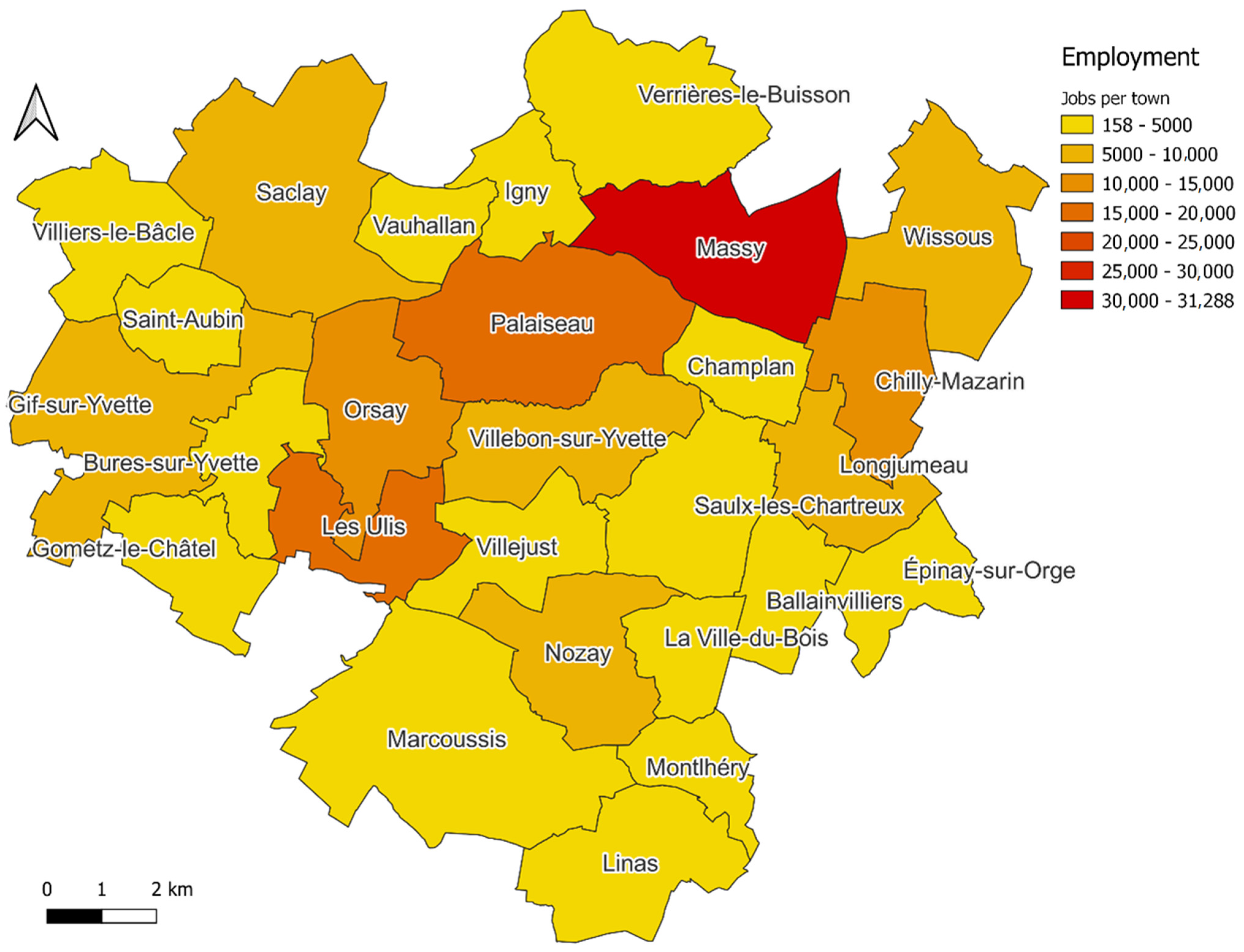
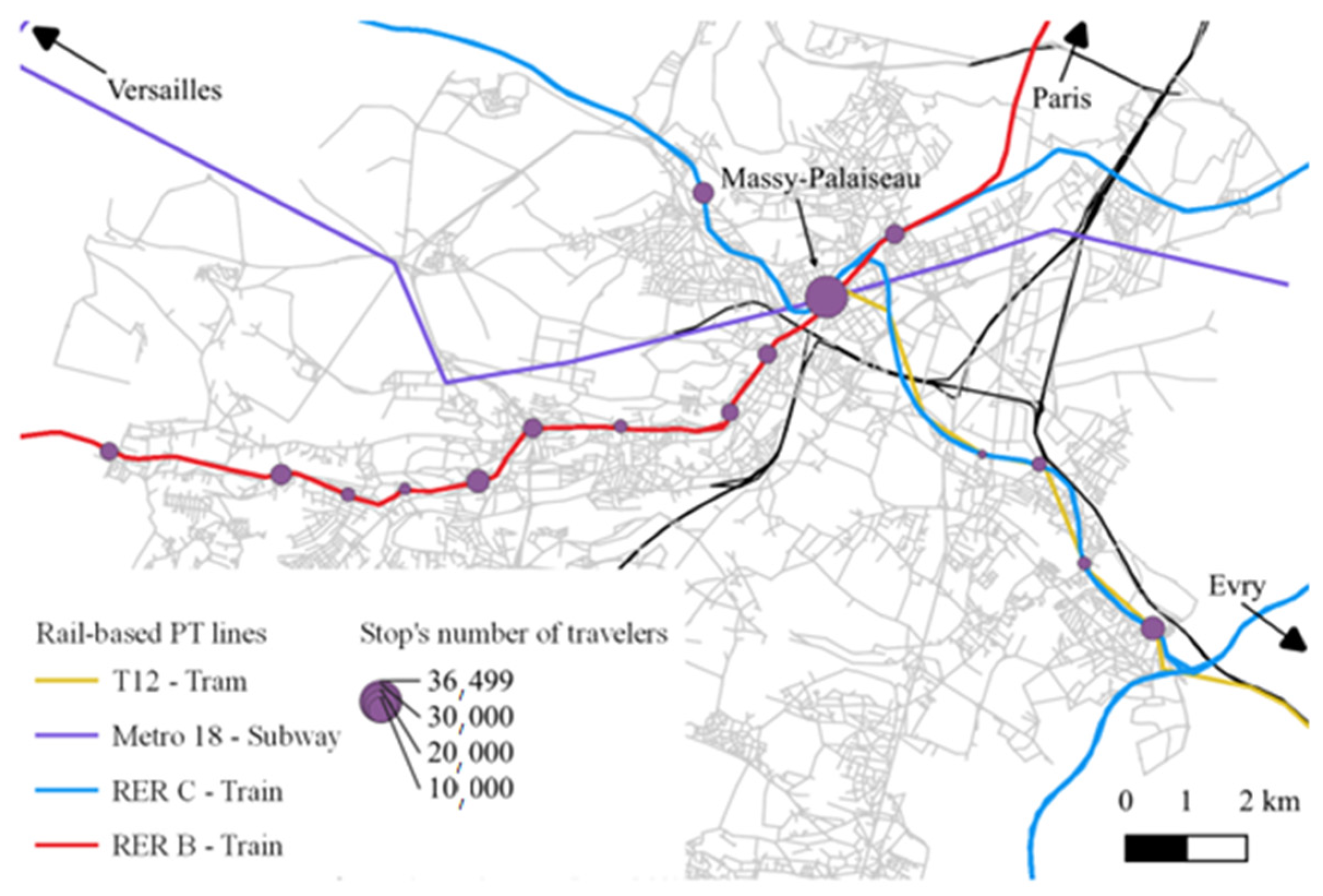
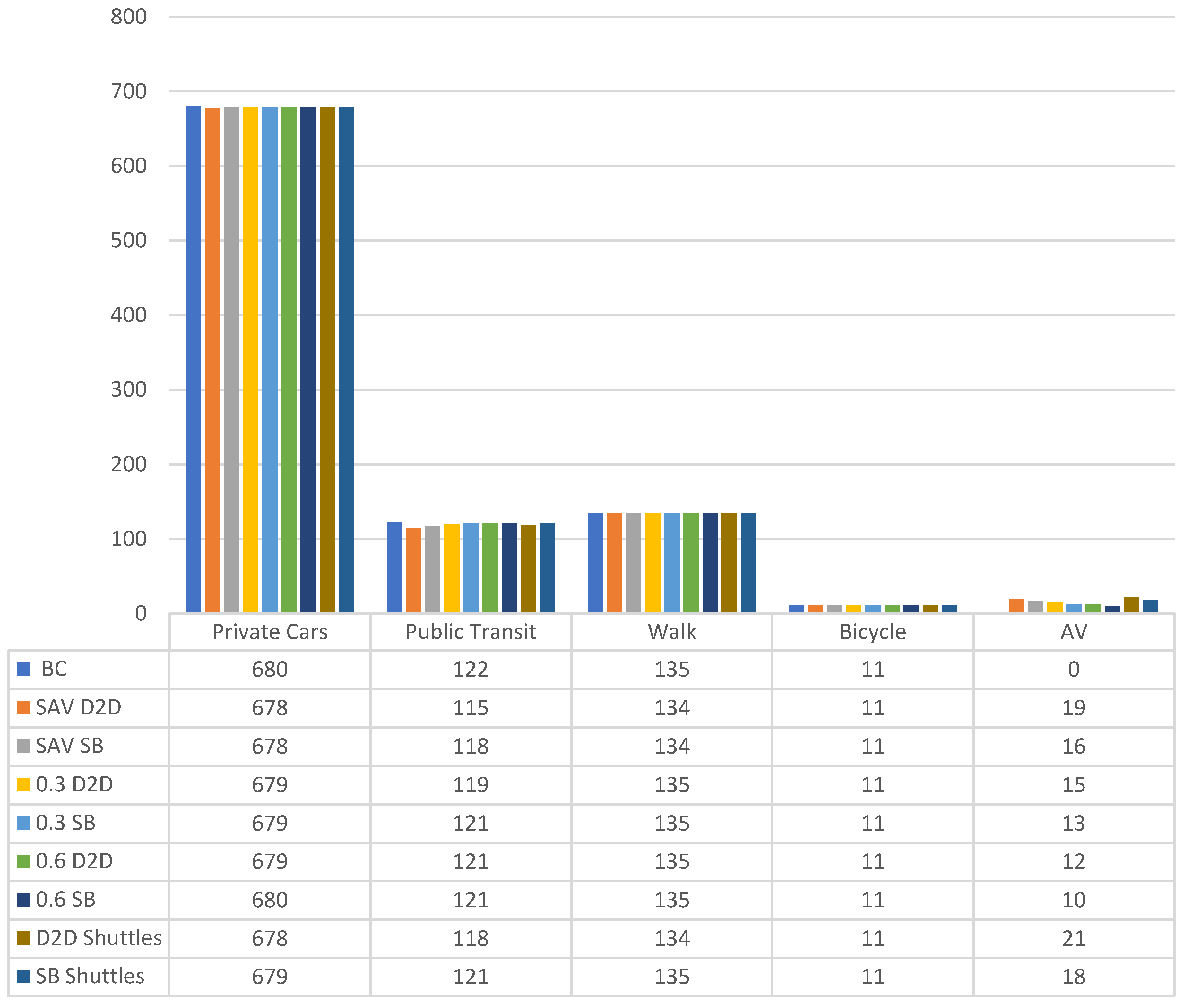


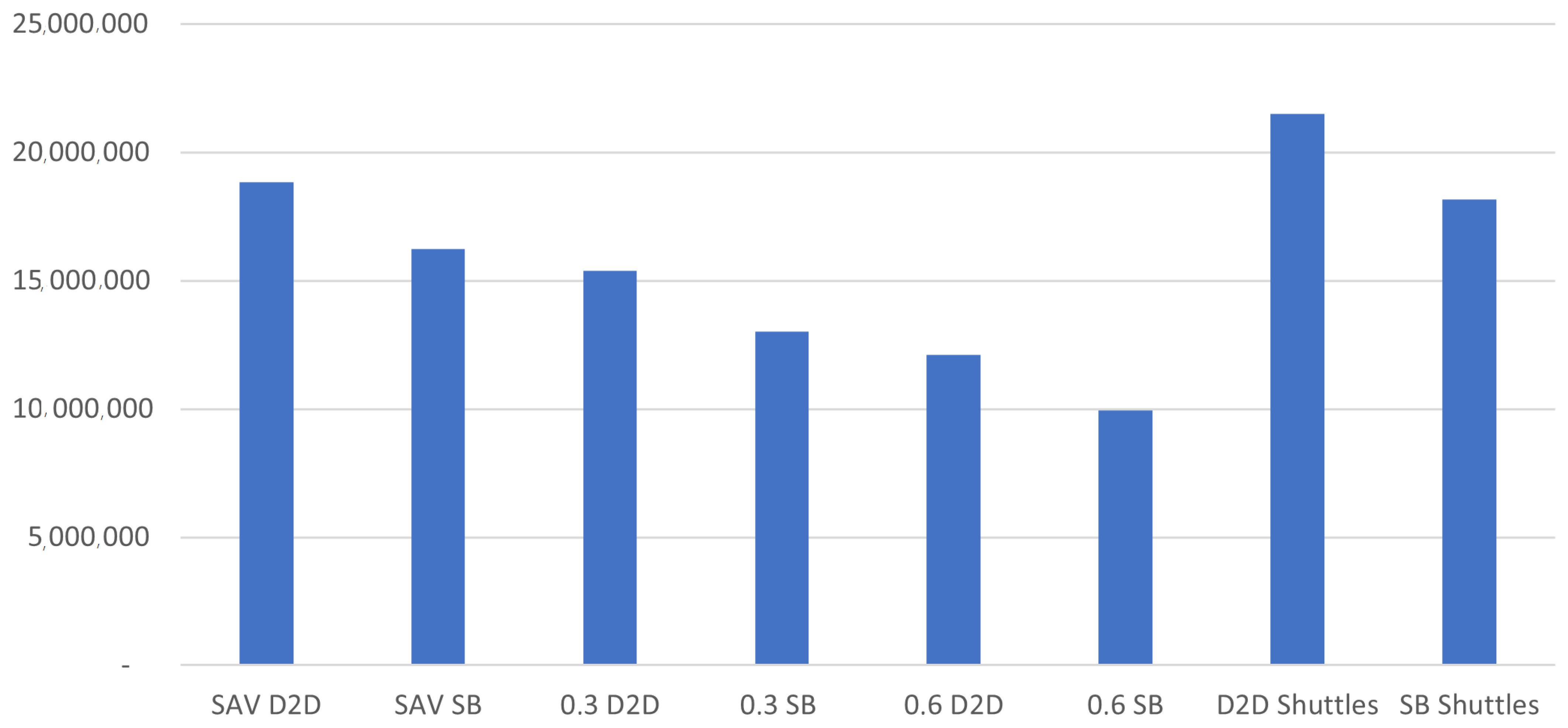


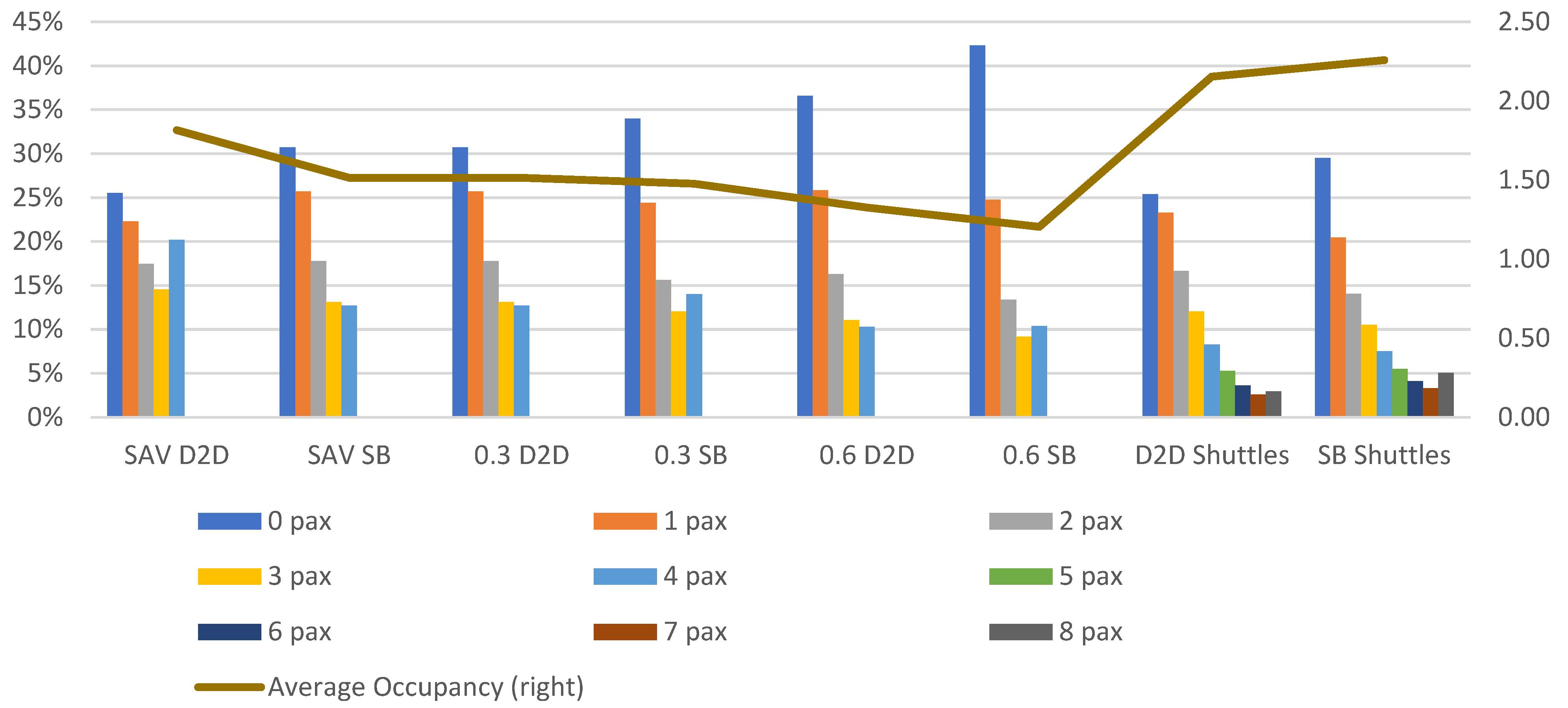
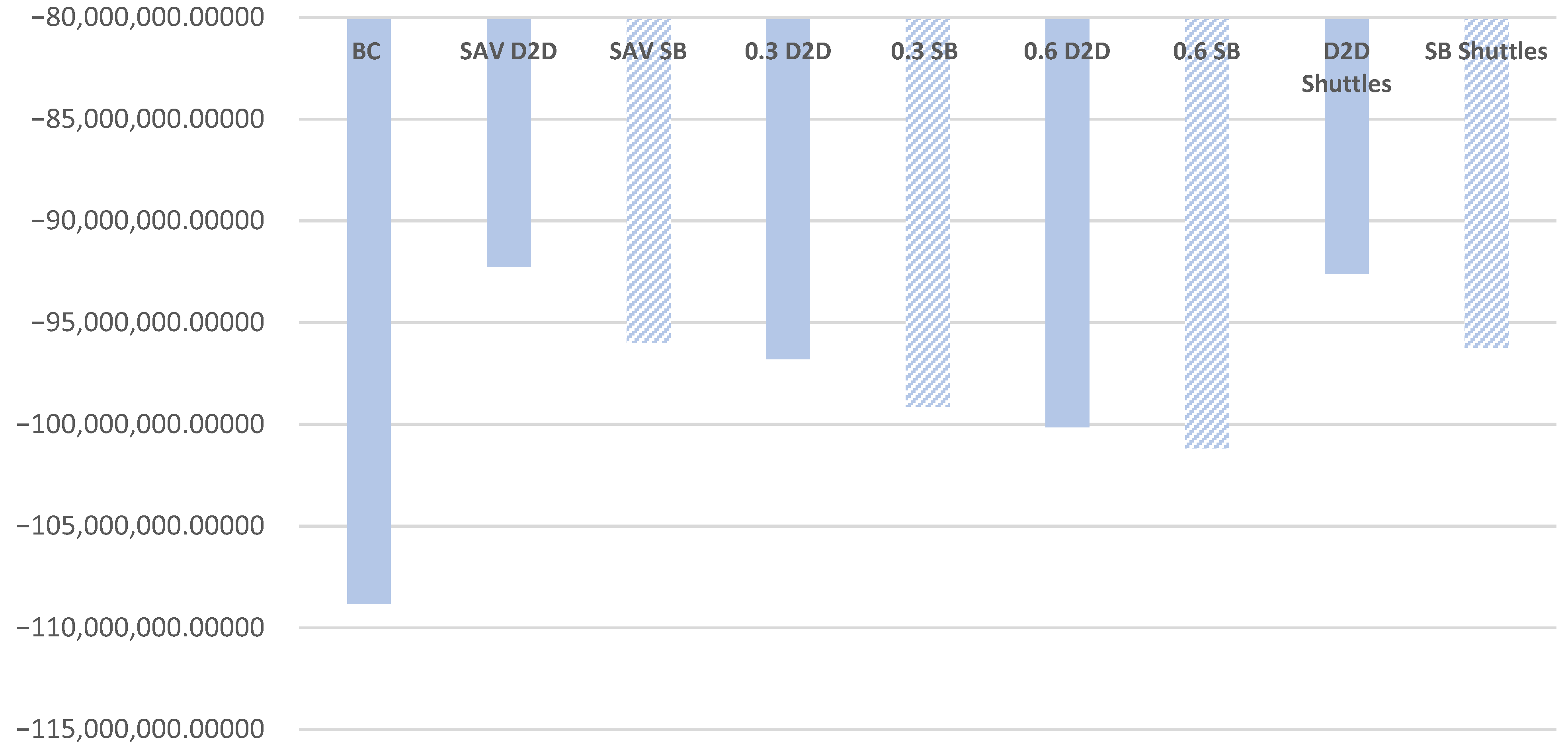

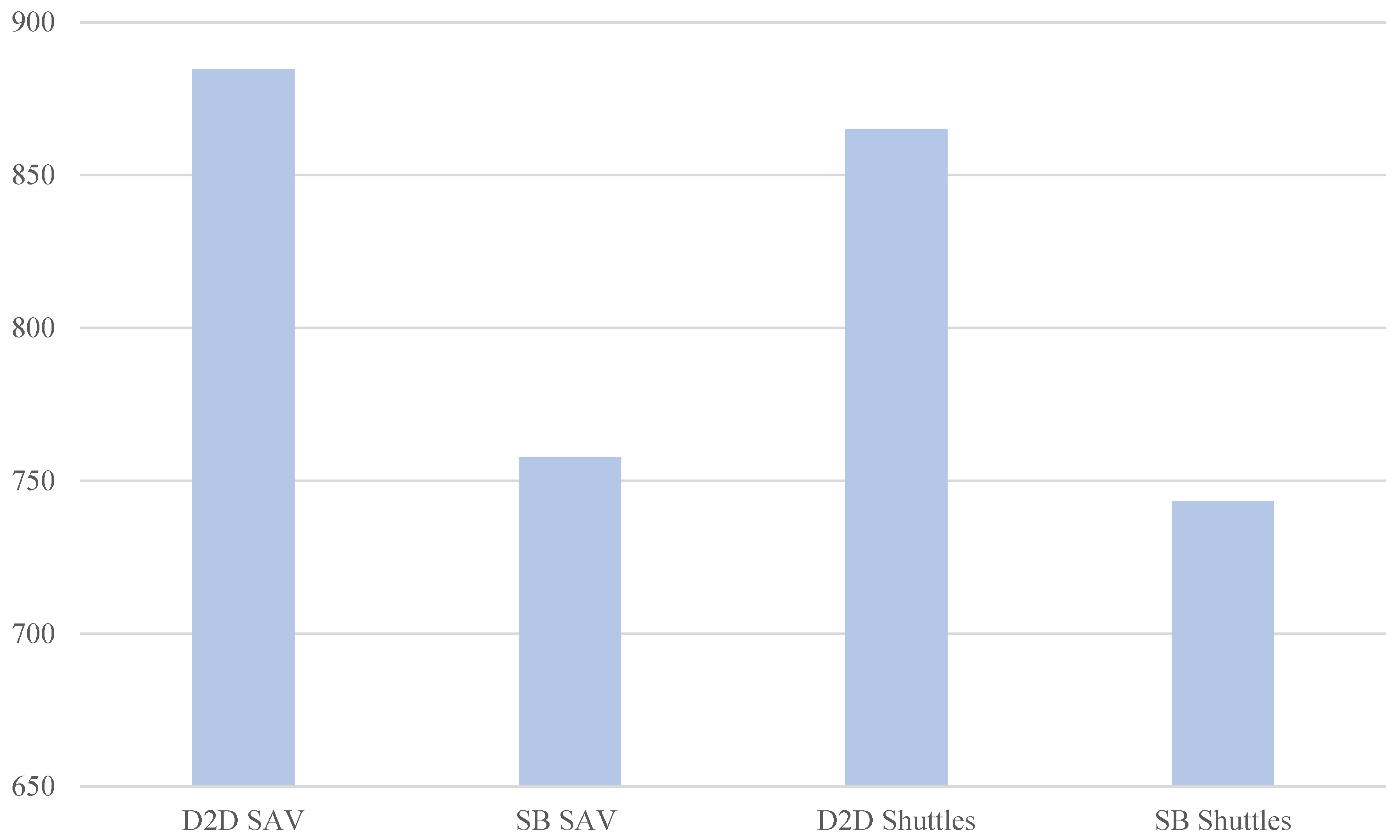

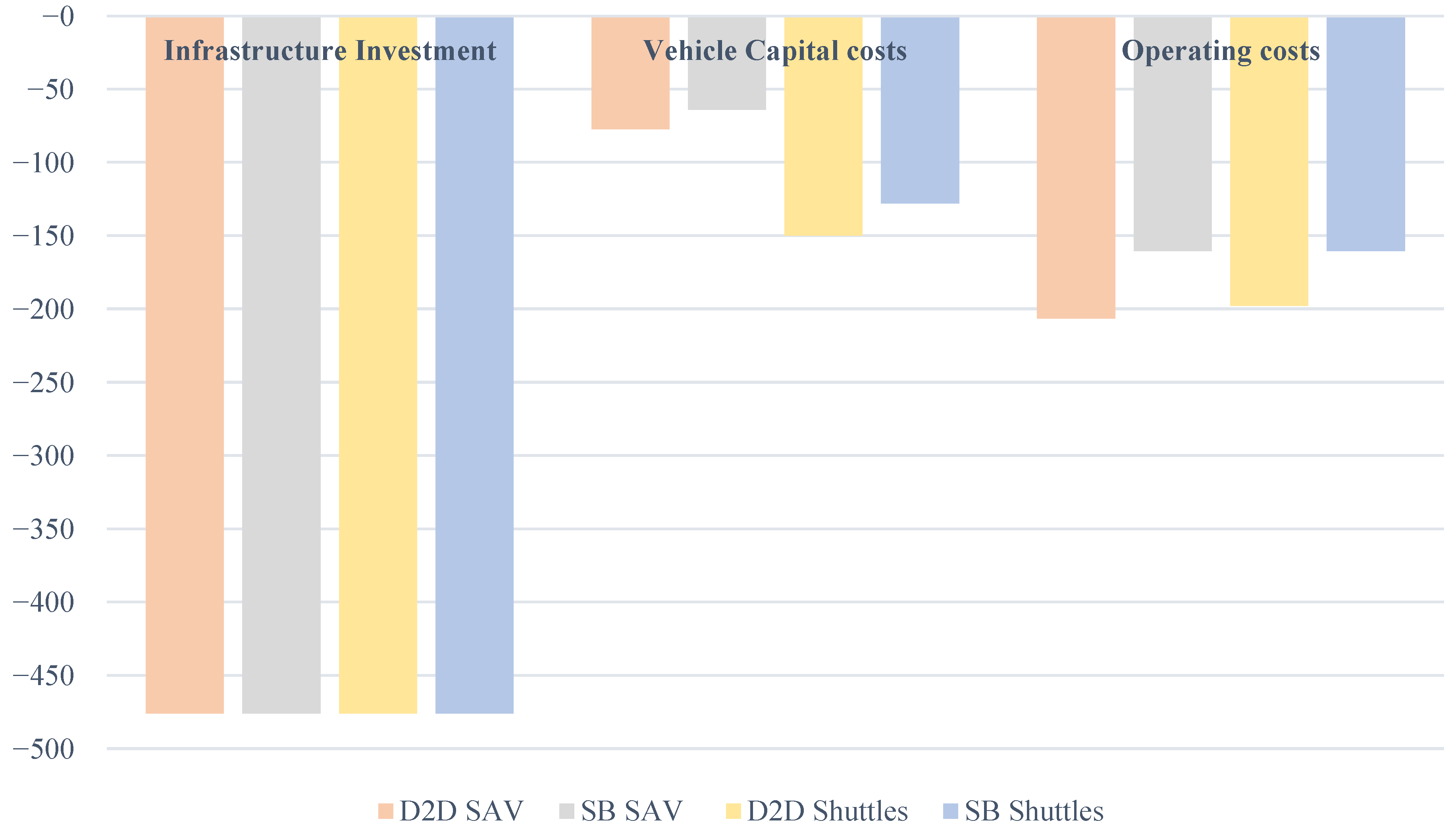
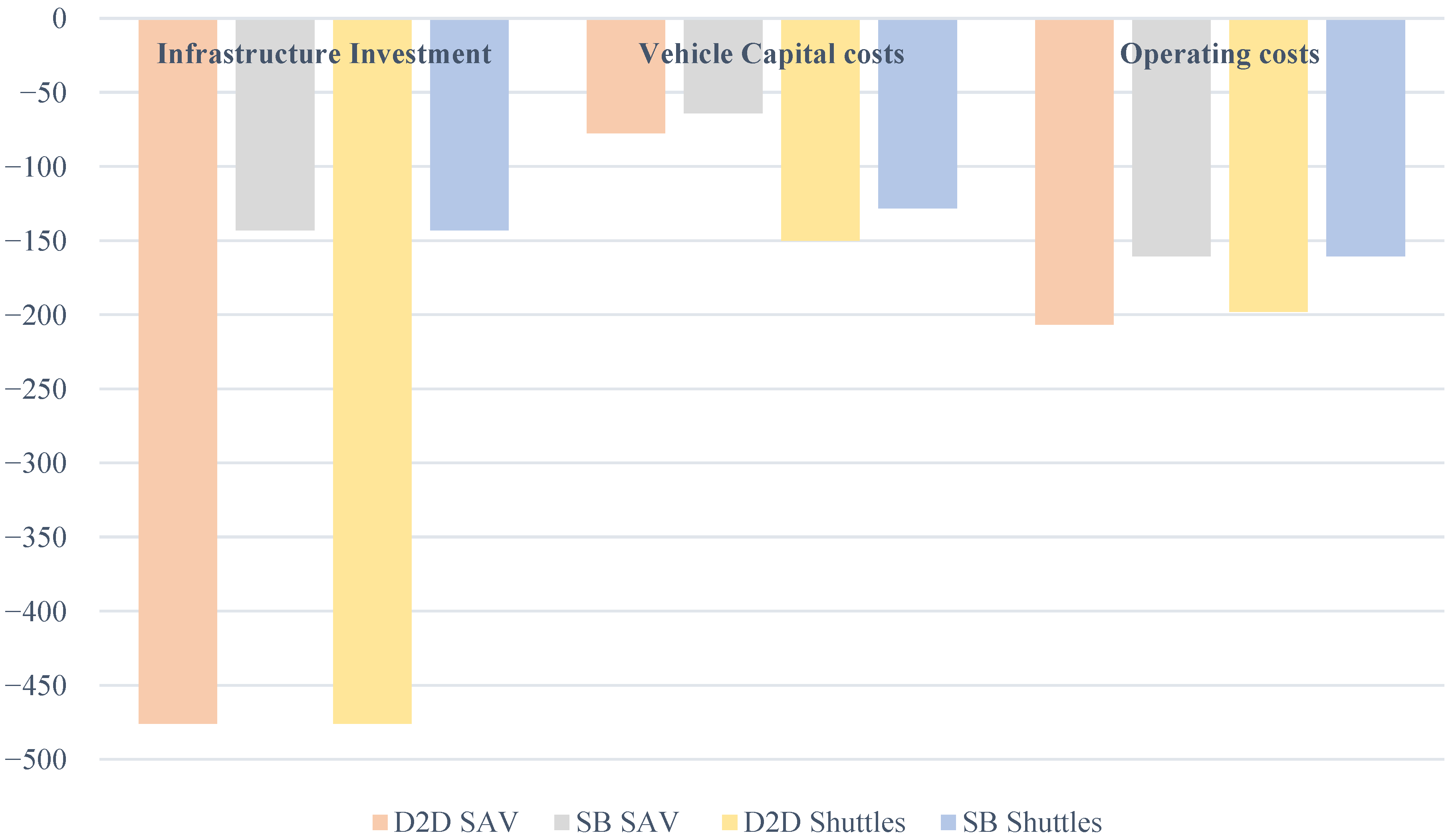
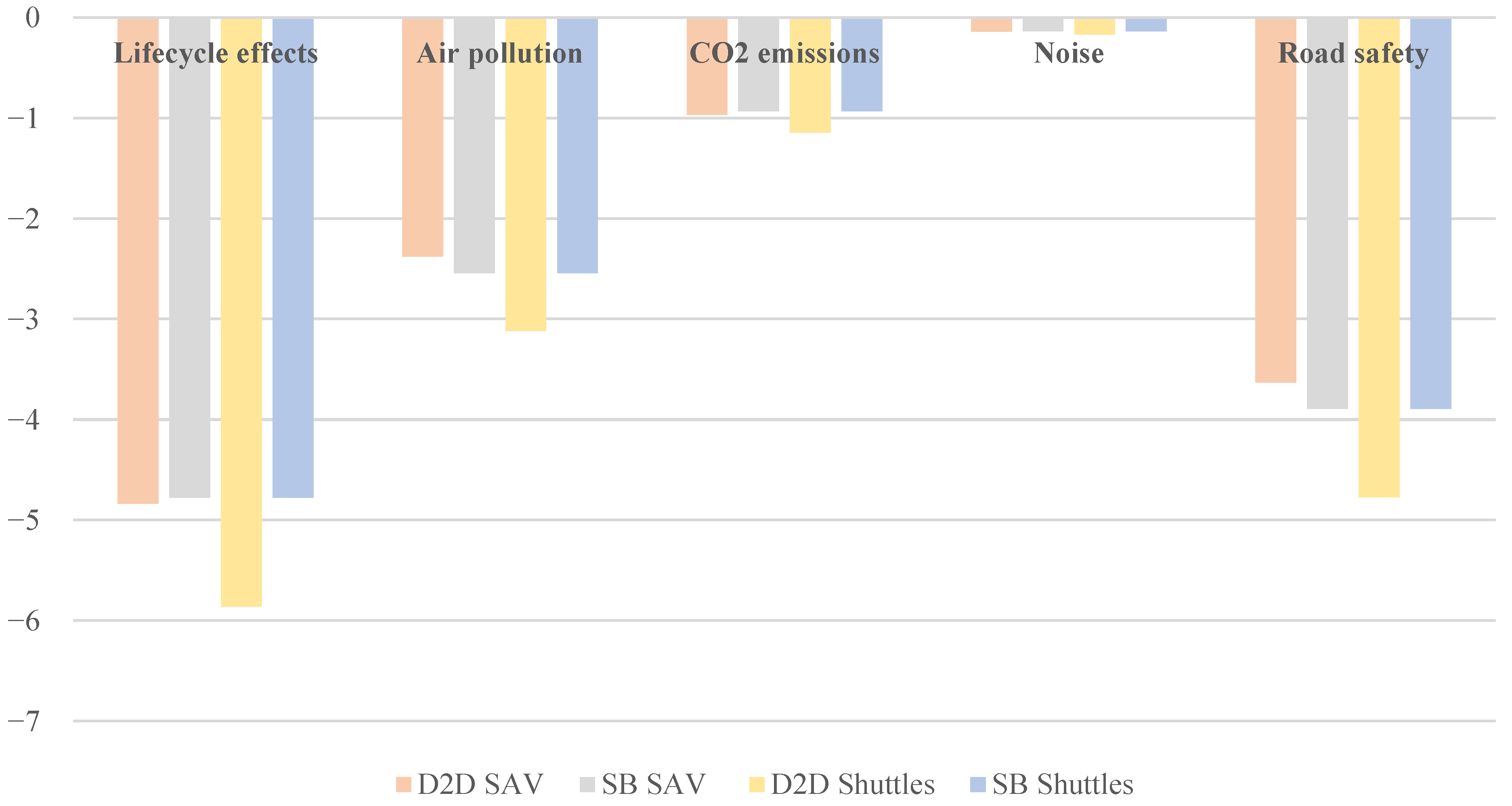
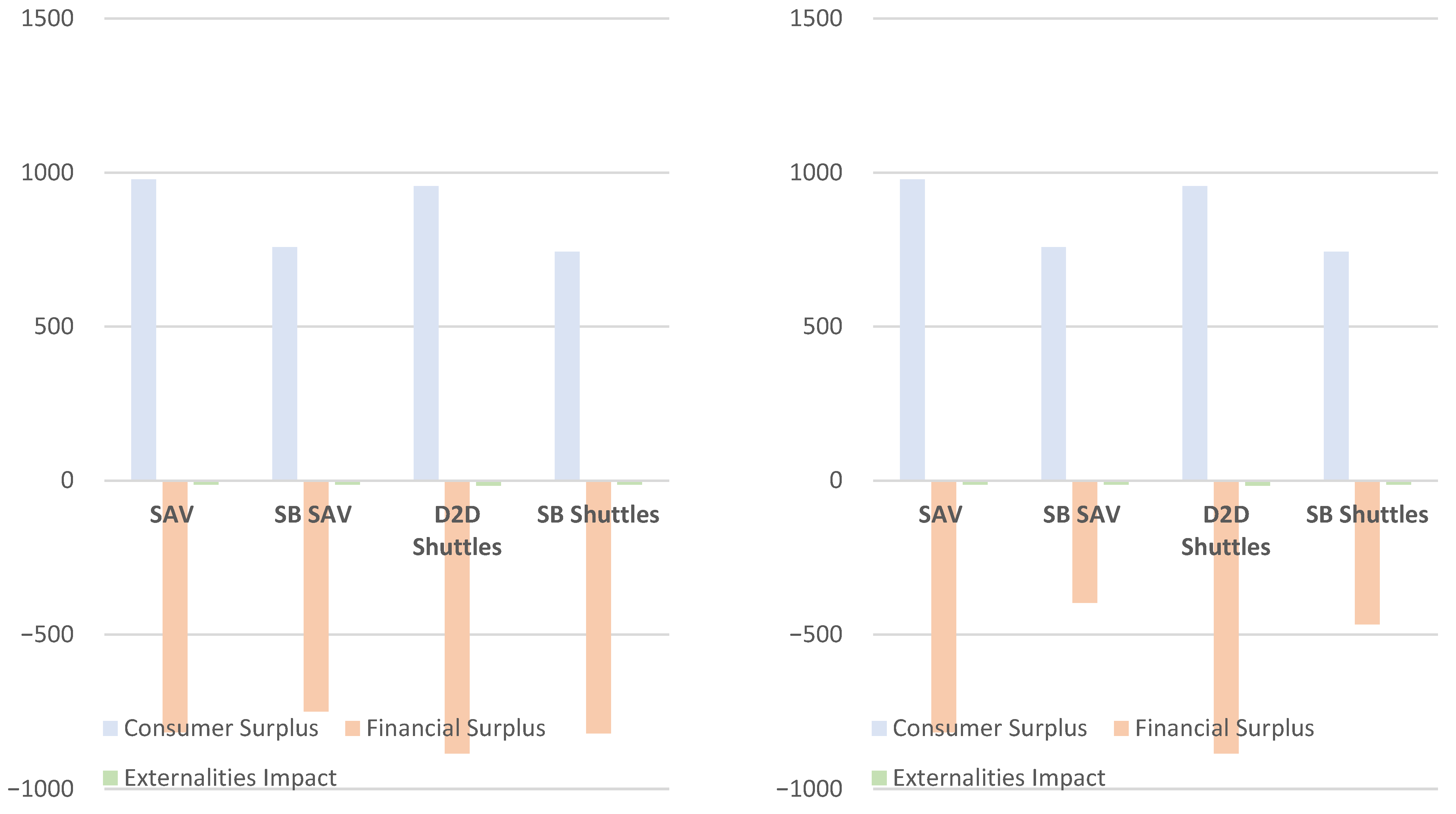
| Name | Ridesharing | Routing | Capacity | Fare (€/km) | Fleet Size | CBA |
|---|---|---|---|---|---|---|
| BC (Basecase) | N/A | N/A | N/A | N/A | N/A | ✓ |
| SAV D2D | Yes | D2D | 4 | 0 | 400 | ✓ |
| SAV SB | Yes | SB | 4 | 0 | 400 | ✓ |
| 0.3 D2D | Yes | D2D | 4 | 0.3 | 400 | |
| 0.3 SB | Yes | SB | 4 | 0.3 | 400 | |
| 0.6 D2D | Yes | D2D | 4 | 0.6 | 400 | |
| 0.6 SB | Yes | SB | 4 | 0.6 | 400 | |
| D2D Shuttles | Yes | D2D | 8 | 0 | 400 | ✓ |
| SB Shuttles | Yes | SB | 8 | 0 | 400 | ✓ |
Disclaimer/Publisher’s Note: The statements, opinions and data contained in all publications are solely those of the individual author(s) and contributor(s) and not of MDPI and/or the editor(s). MDPI and/or the editor(s) disclaim responsibility for any injury to people or property resulting from any ideas, methods, instructions or products referred to in the content. |
© 2025 by the authors. Licensee MDPI, Basel, Switzerland. This article is an open access article distributed under the terms and conditions of the Creative Commons Attribution (CC BY) license (https://creativecommons.org/licenses/by/4.0/).
Share and Cite
Carreyre, F.; Chouaki, T.; Coulombel, N.; Berrada, J.; Bouillaut, L.; Hörl, S. Beyond Traditional Public Transport: A Cost–Benefit Analysis of First and Last-Mile AV Solutions in Periurban Environment. Sustainability 2025, 17, 6282. https://doi.org/10.3390/su17146282
Carreyre F, Chouaki T, Coulombel N, Berrada J, Bouillaut L, Hörl S. Beyond Traditional Public Transport: A Cost–Benefit Analysis of First and Last-Mile AV Solutions in Periurban Environment. Sustainability. 2025; 17(14):6282. https://doi.org/10.3390/su17146282
Chicago/Turabian StyleCarreyre, Félix, Tarek Chouaki, Nicolas Coulombel, Jaâfar Berrada, Laurent Bouillaut, and Sebastian Hörl. 2025. "Beyond Traditional Public Transport: A Cost–Benefit Analysis of First and Last-Mile AV Solutions in Periurban Environment" Sustainability 17, no. 14: 6282. https://doi.org/10.3390/su17146282
APA StyleCarreyre, F., Chouaki, T., Coulombel, N., Berrada, J., Bouillaut, L., & Hörl, S. (2025). Beyond Traditional Public Transport: A Cost–Benefit Analysis of First and Last-Mile AV Solutions in Periurban Environment. Sustainability, 17(14), 6282. https://doi.org/10.3390/su17146282






